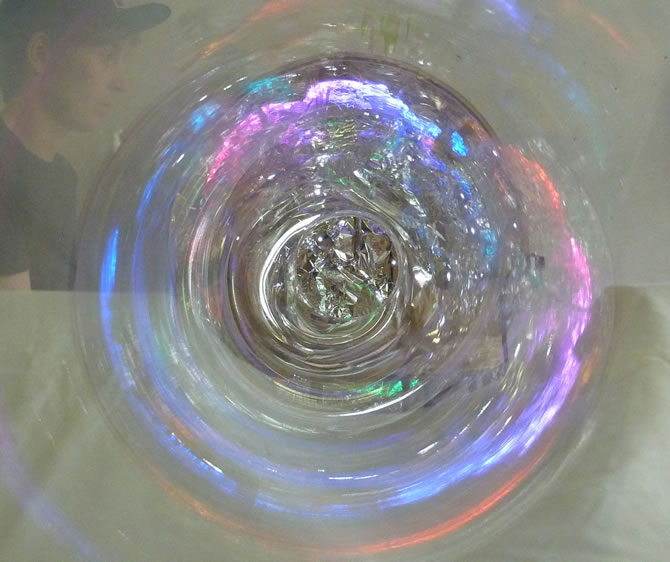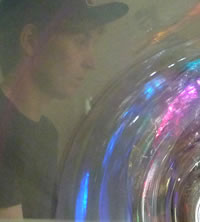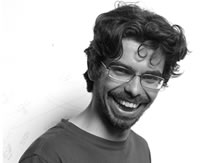Deb Todd Wheeler + Bec Conrad + Michael Nagle
Chromatic Energy Mirror

Energy from Brandeis Student Center represented thru shifts in LED color, seen through a glass tube, 12” round x 5’ deep
How much do we know about the energy we use? With the right tools, our city’s buildings could tell us directly about the energy used within and give us insight into when our system is strained and close to a brownout and when it has the resources available for normal usage. Can we create a daily energy report that is a part of our morning routines like the weather report?
The Chromatic Energy Mirror is a platform for equipping a building with a unique and particular visual display of how much energy it is using. The Mirror serves as a platform for different artists, engineers and interested citizens, young and old, to come together to build their own visual art installation to represent their site’s energy usage. Every Mirror starts with two common elements—the circular “mirror” base and programmable colored LEDs to indicate power usage. Beyond these common elements, every Mirror will be customized according to the site. The Chromatic Energy Mirror team will work with an interested group to establish a Test Site and help lead workshops to brainstorm the best visual response for communicating awareness of peak energy usage in their Test Site.
Our vision for this project is to foster community participation in the transformation of habitual unthinking energy use into a visible creative space for energy awareness and re-education. Over time, we feel that a deep and natural awareness of our energy grids will be as common as our awareness of our weather systems: we’ll know when there’s strain on the grid in the same way that we know when it’s likely to rain. Knowing there is a spike in usage might impact one’s choice of when to run an appliance, just like knowing it’s going to rain impacts one’s choice of shoes that day.
Test Site #1 Brandeis University (Spring 2013). At Brandeis, a team of students worked with data from the student center buildings and conducted a series of experiments around visualizing rate fluctuation through color, sound and motion. (AIC note: this development phase was funded by the Barr Foundation.)
Test Site #2 is slated for Babson College (Spring 2014).There will be an exhibit of further experiments with data from the Babson campus, conducted in partnership with Wellesley College students.
Test Site #3 is not yet determined. Please contact us if you are interested in organizing a test site in your community.
Video of energy used by Brandeis Student Center represented thru shifts in LED color within wooden form, 36” round x 10” deep
In this experiment, a stepper motor pushes and pulls a disc of flexible rubber surface, 24” x 10” x 10,” indicating peaks and valleys of energy rate changes. The color is from a surveillance camera, projecting imagery of the surrounding area.

Energy from Brandeis Student Center represented thru shifts in LED color, seen through a glass tube, 12” round x 5’ deep

Energy used by Brandeis Student Center represented thru shifts in LED color, seen through a glass tube, 12” round x 5’ deep

Energy used by Brandeis Student Center represented through shifts in LED color within wooden frame , 36” round x 10” deep

In this student experiment, corn starch and water (ooblick) respond to changing audio frequency. The form of the ooblick shifts and moves in different patterns, depending on the frequency rate delivered. 1” x 1”
 Deb Todd Wheeler is a media artist who produces installations, photographs and sculptural objects that explore the aesthetic impact of human productivity in the natural world. Her studio sits in a turn-of-the century locomotive factory in Hyde Park, MA, a section of the city of Boston known for manufacturing and its proximity to the 7,000-acre Blue Hills Reservation. From the studio she feels a clash between the desire to be productive, to be industrious, to push technology forward and the fraught consequences this desire reaps: through the impact of waste, residue and other costs of productivity, such as the toxic mine pits of mining, to the human cost in labor practices. Her work draws a bit from the 19th century, a time when artists and scientists were more closely linked for their compatible skills in both examining and documenting the natural world, and a bit from the industrious DIY culture of the 1960s. She has worked on power-generating interactive installations that compel the public to work, through physical exertion, creative crafting, or poetic gesture, each person exploring ideas of labor and productivity in his or her own way. In recent years she has been engaged in a material study of polyethylene plastic that has resulted in many projects, from performance based inflatables to 2D experiments with a scanner. Her collaborative projects include unlikely partnerships with Maine sea snails, western harvester ants and other unwitting creatures. She also has collaborated with artists, engineers and scientists on various projects involving questions of sustainability, risk, failure and observation. This latest collaboration with Michael Nagle and Bec Conrad feeds her ongoing interest in energy as an inevitable byproduct of productivity.
Deb Todd Wheeler is a media artist who produces installations, photographs and sculptural objects that explore the aesthetic impact of human productivity in the natural world. Her studio sits in a turn-of-the century locomotive factory in Hyde Park, MA, a section of the city of Boston known for manufacturing and its proximity to the 7,000-acre Blue Hills Reservation. From the studio she feels a clash between the desire to be productive, to be industrious, to push technology forward and the fraught consequences this desire reaps: through the impact of waste, residue and other costs of productivity, such as the toxic mine pits of mining, to the human cost in labor practices. Her work draws a bit from the 19th century, a time when artists and scientists were more closely linked for their compatible skills in both examining and documenting the natural world, and a bit from the industrious DIY culture of the 1960s. She has worked on power-generating interactive installations that compel the public to work, through physical exertion, creative crafting, or poetic gesture, each person exploring ideas of labor and productivity in his or her own way. In recent years she has been engaged in a material study of polyethylene plastic that has resulted in many projects, from performance based inflatables to 2D experiments with a scanner. Her collaborative projects include unlikely partnerships with Maine sea snails, western harvester ants and other unwitting creatures. She also has collaborated with artists, engineers and scientists on various projects involving questions of sustainability, risk, failure and observation. This latest collaboration with Michael Nagle and Bec Conrad feeds her ongoing interest in energy as an inevitable byproduct of productivity.
Recent exhibitions include EXCHANGE at the ICA at MeCA and ones at the Ellen Miller Gallery, The New Britain Museum of American Art, the Islip Art Museum, St Gaudens Museum and the Megapolis Audio Art and Documentary Festival. Her work was chosen by both The Boston Globe and The Boston Phoenix as “Best Exhibitions of 2010” and was awarded the Best Solo Exhibition and Best New Media of 2010 in the New England Journal of Aesthetic Research annual awards. She has also received an individual artist grant from the Artist Resource Trust, a LEF Contemporary Work Fund Artist grant in Inter-media, a Massachusetts Cultural Council Grant in Sculpture and Installation as well as one in Photography. She teaches in the 3D Department at Massachusetts College of Art and Design and is on the Graduate Faculty at the Art Institute of Boston. She spent the 2012/2013 academic year at Brandeis University working as a member of the sculpture faculty and with a team of students on a campus sculpture commission that now resides in the Volen Center for Complex Systems.
 Bec Conrad is an engineer who is trying to become an artist. She’s passionate about making a positive impact, hand crafting objects and developing an understanding of the physical world of motion. As a day job, she builds robots that are meant to neutralize underwater explosives. With a Master of Science in Mechanical Engineering, she has helped build animatronic dragons for Dreamworks, a wheelchair that climbs up stairs and a home hemodialysis machine. Outside of work, she often thinks about making machines that help us take time to reflect and enable our minds to practice seeing through the minds of others. She hopes to put her dreams into action starting Fall 2013 as a graduate student working for Kelly Dobson at Rhode Island School of Design.
Bec Conrad is an engineer who is trying to become an artist. She’s passionate about making a positive impact, hand crafting objects and developing an understanding of the physical world of motion. As a day job, she builds robots that are meant to neutralize underwater explosives. With a Master of Science in Mechanical Engineering, she has helped build animatronic dragons for Dreamworks, a wheelchair that climbs up stairs and a home hemodialysis machine. Outside of work, she often thinks about making machines that help us take time to reflect and enable our minds to practice seeing through the minds of others. She hopes to put her dreams into action starting Fall 2013 as a graduate student working for Kelly Dobson at Rhode Island School of Design.
 Michael Nagle is very, very interested in how people learn. He’s founded two non-profits: Kaleidoscope Education (2006) and sprout & co. (2008 as co-founder), both of which explored new ideas in how people can learn and be creative in their everyday lives. Most recently, he has become interested in the arts and the sciences for vehicles of creativity—where learning and creating are integral parts of our daily lives. For Michael the Chromatic Energy Mirror is a meaningful project, as it uses the arts to foster engagement with one of the key issues of our time—energy usage—in a way that attempts to be radically interesting and genuinely fun.
Michael Nagle is very, very interested in how people learn. He’s founded two non-profits: Kaleidoscope Education (2006) and sprout & co. (2008 as co-founder), both of which explored new ideas in how people can learn and be creative in their everyday lives. Most recently, he has become interested in the arts and the sciences for vehicles of creativity—where learning and creating are integral parts of our daily lives. For Michael the Chromatic Energy Mirror is a meaningful project, as it uses the arts to foster engagement with one of the key issues of our time—energy usage—in a way that attempts to be radically interesting and genuinely fun.
“SURGE” Art/Energy-Use Project at Babson College through May 20, 2014
Wheeler Residency in Iceland


